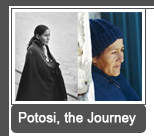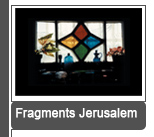
 |
 |
 |
 |
In 1970, after their wedding in Buenos Aires, Ron and Jacqueline set off for the Andes to visit Cuzco and Machu Picchu, the cradles of the Inca civilization. With their backpacks and still cameras, they crossed Bolivia and discovered the city of Potosi. The black and white photos that they brought back and the memory of this first journey, made when they were 20, form the foundation for the film.
29 years later, in 1999, they set off on a new journey, from Buenos Aires to Potosi, following their 1970 itinerary. Their three daughters accompany them. Naomi (19) records the sound. Yael (21) is photographer. Noa (24), a student in architecture, joins the family along the way. Ron films the journey with a Super 16 camera.
A long stay in Potosi makes up the greater part of this journey whose day-to-day events form the central axis of the film.
Potosi, at an altitude of 4,100 metres, was once the world's biggest silver mine. The main source of wealth for the Spanish Empire, the silver from Potosi, having become a world monetary standard, would fuel the rise of capitalism.
Sumptuous baroque architecture and a lavish lifestyle rubbed shoulders with overwhelming distress. For millions of indigenous people from the Andes, forced to work in the depths of the mine in terrifying conditions, Potosi was the gateway to Hell. As soon as its silver mines were exhausted, Potosi was abandoned, poor and forgotten.
Through a series of encounters, the film paints the portrait of a city and its inhabitants. A portrait that is all the more moving because it is placed within real time, marked by the passing years.
The memory of the old journey is fragmentary, silent and ghostly, a distant reality frozen in black and white. In contrast, the account of the new journey is vibrant, full of sound, shot in colour and in motion, painstakingly and faithfully reconstructed through editing, with the spirit of observation of the real world that once inspired painters and photographers.
The passing years also sketch the portrait of an Israeli family on the road set against the generation gap and thoughts about the bonds that unite the parents 29 years after their honeymoon trip. This is the third axis of the film, that of introspectionů its "home movie" aspect.
That leaves the material making up the film — image and sound — that give it such an original form. The passage from photography to cinematography, from silence to sound, causes us to reflect upon the power of images and sounds to get across the experience of a journey.
29 years later, in 1999, they set off on a new journey, from Buenos Aires to Potosi, following their 1970 itinerary. Their three daughters accompany them. Naomi (19) records the sound. Yael (21) is photographer. Noa (24), a student in architecture, joins the family along the way. Ron films the journey with a Super 16 camera.
A long stay in Potosi makes up the greater part of this journey whose day-to-day events form the central axis of the film.
Potosi, at an altitude of 4,100 metres, was once the world's biggest silver mine. The main source of wealth for the Spanish Empire, the silver from Potosi, having become a world monetary standard, would fuel the rise of capitalism.
Sumptuous baroque architecture and a lavish lifestyle rubbed shoulders with overwhelming distress. For millions of indigenous people from the Andes, forced to work in the depths of the mine in terrifying conditions, Potosi was the gateway to Hell. As soon as its silver mines were exhausted, Potosi was abandoned, poor and forgotten.
Through a series of encounters, the film paints the portrait of a city and its inhabitants. A portrait that is all the more moving because it is placed within real time, marked by the passing years.
The memory of the old journey is fragmentary, silent and ghostly, a distant reality frozen in black and white. In contrast, the account of the new journey is vibrant, full of sound, shot in colour and in motion, painstakingly and faithfully reconstructed through editing, with the spirit of observation of the real world that once inspired painters and photographers.
The passing years also sketch the portrait of an Israeli family on the road set against the generation gap and thoughts about the bonds that unite the parents 29 years after their honeymoon trip. This is the third axis of the film, that of introspectionů its "home movie" aspect.
That leaves the material making up the film — image and sound — that give it such an original form. The passage from photography to cinematography, from silence to sound, causes us to reflect upon the power of images and sounds to get across the experience of a journey.